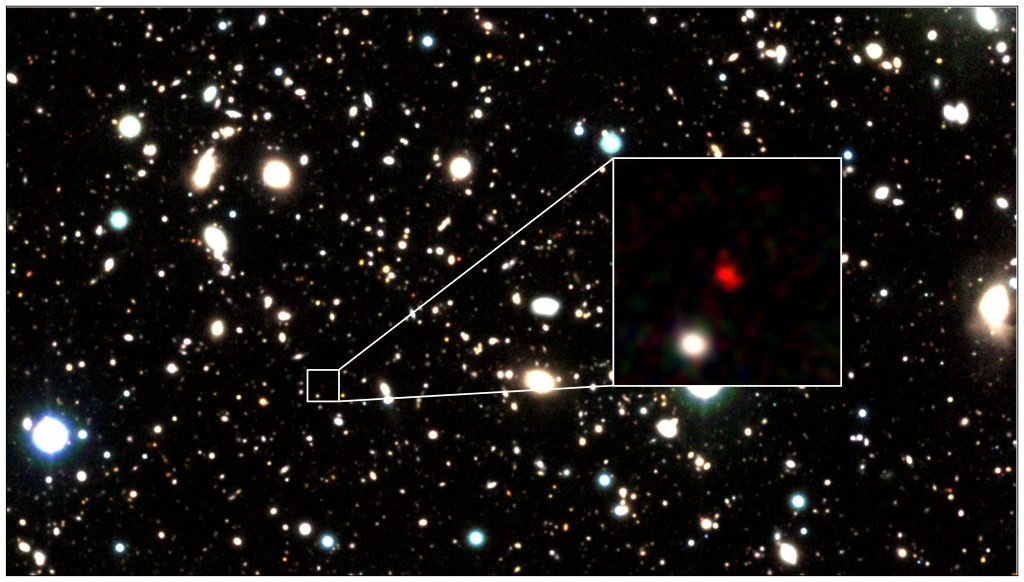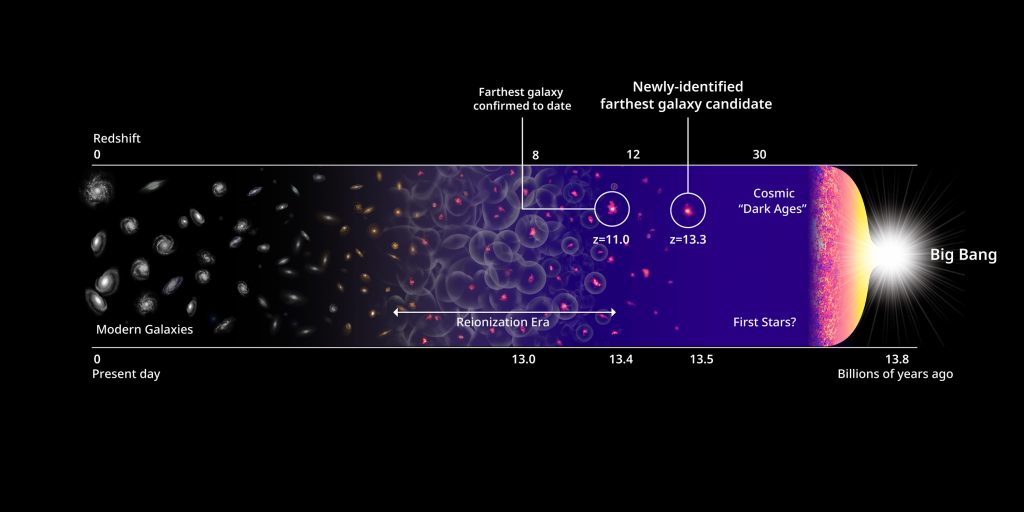Institute for Cosmic Ray Research, The University of Tokyo
Waseda University
National Astronomical Observatory of Japan
Nagoya University
National Institute of Technology, Toba College
Tsukuba University
University of Groningen
Center for Astrophysics, Harvard & Smithsonian

An international astronomer team has discovered the most distant galaxy candidate to date, named HD1, which is about 13.5 billion light-years away. This discovery implies that bright systems like HD1 existed as early as 300 million years after the Big Bang. This galaxy candidate is one of the targets of the James Webb Space Telescope launched late last year. If observations with the James Webb Space Telescope confirm its exact distance, HD1 will be the most distant galaxy ever recorded.
To understand how and when galaxies formed in the early Universe, astronomers look for distant galaxies. Because of the finite speed of light, it takes time for the light from distant objects to reach Earth. If an object is 1 billion light-years away, it means that the light left that object 1 billion years ago and had to travel for 1 billion years to reach us. Thus studying distant galaxies lets us look back in time.
The current record holder for the most distant galaxy is GN-z11, a galaxy 13.4 billion light-years away discovered by the Hubble Space Telescope. However, this distance is about the limit of Hubble’s detection capabilities.
HD1, a candidate object for the earliest/most-distant galaxy at 13.5 billion light-years away, was discovered from more than 1,200 hours of observation data taken by the Subaru Telescope, VISTA Telescope, UK Infrared Telescope, and Spitzer Space Telescope. “It was very hard work to find HD1 out of more than 700,000 objects,” says Yuichi Harikane, an assistant professor of ICRR, the University of Tokyo, who discovered HD1. “HD1’s red color matched the expected characteristics of a galaxy 13.5 billion light-years away surprisingly well, giving me a little bit of goosebumps when I found it.”
The team conducted follow-up observations using the Atacama Large Millimeter/submillimeter Array (ALMA) to confirm HD1’s distance. Akio Inoue, a professor at Waseda University, who led the ALMA observations, says, “We found a weak signal at the frequency where an oxygen emission line was expected. The significance of the signal is 99.99%. If this signal is real, this is evidence that HD1 exists 13.5 billion light-years away, but we cannot be sure without a significance of 99.9999% or more.”
HD1 is very bright, suggesting that bright objects already existed in the Universe only 300 million years after the Big Bang. HD1 is difficult to explain with current theoretical models of galaxy formation. Observational information on HD1 is limited and its physical properties remain a mystery. It is thought to be a very active star-forming galaxy, but it might be an active black hole. Either possibility makes it a very interesting object. In recognition of its astronomical importance, HD1 was selected as a target for the cycle 1 observations by the James Webb Space Telescope, launched last year. Yuichi Harikane, who is leading these observations, says, “If the spectroscopic observation confirms its exact distance, HD1 will be the most distant galaxy ever recorded, 100 million light-years further away than GN-z11. We are looking forward to seeing the Universe with the James Webb Space Telescope.”
This research will be published in the April 8, 2022 issue of The Astrophysical Journal as Yuichi Harikane, et al. “A Search for H-Dropout Lyman Break Galaxies at z~12-16”. This work was supported by the Japanese Ministry of Education, Culture, Sports, Science and Technology (MEXT), the Japan Society for the Promotion of Science (17H06130, 19J01222, 20K22358, 21K13953), and the NAOJ ALMA Scientific Research Grant (2020-16B).

(Credit: Harikane et al., NASA, ESA, and P. Oesch (Yale University))
Journal: The Astrophysical Journal
Title: “A Search for H-Dropout Lyman Break Galaxies at z~12-16”
Authors: Yuichi Harikane, Akio K. Inoue, Ken Mawatari, Takuya Hashimoto, Satoshi, Yamanaka, Yoshinobu Fudamoto, Hiroshi Matsuo, Yoichi Tamura, Pratika Dayal, L. Y. Aaron Yung, Anne Hutter, Fabio Pacucci, Yuma Sugahara, and Anton M. Koekemoer
DOI:10.3847/1538-4357/ac53a9
URL:https://iopscience.iop.org/article/10.3847/1538-4357/ac53a9 https://ui.adsabs.harvard.edu/abs/2021arXiv211209141H/abstract





